CURATOR INDEX
|
|
STATUS: Out of stock Temporarily out of stock pending additional inventory. |
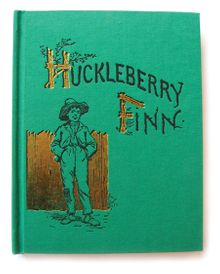 Huckleberry Finn
Huckleberry Finn
Published by CCA Wattis Institute for Contemporary Arts.
Edited by Jens Hoffmann. Text by Jens Hoffmann, Maurice Berger, Mirjana Blankenship, Elyse Mallouk.
PUBLISHER
CCA Wattis Institute for Contemporary Arts
BOOK FORMAT
Clth, 6.5 x 8.5 in. / 108 pgs / 39 color / 5 bw / 13 duotone.
PUBLISHING STATUS
Pub Date 4/30/2011
Out of stock indefinitely
DISTRIBUTION
D.A.P. Exclusive
Catalog: SPRING 2011 p. 59
PRODUCT DETAILS
ISBN 9780980205596 TRADE
List Price: $35.00 CAD $47.50 GBP £30.00
AVAILABILITY
Not available
STATUS: Out of stock indefinitely. |
 Dana Hoey: Experiments in Primitive Living
Dana Hoey: Experiments in Primitive Living
Published by Center for Art, Design and Visual Culture, UMBC.
By Maurice Berger.
PUBLISHER
Center for Art, Design and Visual Culture, UMBC
BOOK FORMAT
Hardcover, 6.5 x 9.75 in. / 32 pgs / 47 color.
PUBLISHING STATUS
Pub Date 3/31/2010
Active
DISTRIBUTION
D.A.P. Exclusive
Catalog: SPRING 2010 p. 157
PRODUCT DETAILS
ISBN 9781890761134 TRADE
List Price: $19.95 CAD $27.95 GBP £17.50
AVAILABILITY
In stock
in stock $19.95 Free Shipping UPS GROUND IN THE CONTINENTAL U.S. |
 Andrea Robbins & Max Becher: Portraits
Andrea Robbins & Max Becher: Portraits
Published by Center for Art, Design and Visual Culture, UMBC.
Text by Maurice Berger.
PUBLISHER
Center for Art, Design and Visual Culture, UMBC
BOOK FORMAT
Paperback, 10 x 12 in. / 64 pgs / 24 color / 6 bw.
PUBLISHING STATUS
Pub Date 2/1/2008
Active
DISTRIBUTION
D.A.P. Exclusive
Catalog: SPRING 2008 p. 191
PRODUCT DETAILS
ISBN 9781890761110 TRADE
List Price: $24.95 CAD $33.95 GBP £22.00
AVAILABILITY
In stock
in stock $24.95 Free Shipping UPS GROUND IN THE CONTINENTAL U.S. |
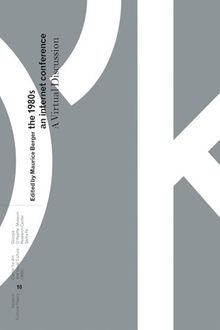 The 1980s: An Internet Conference
The 1980s: An Internet Conference
Published by The Center for Art, Design and Visual Culture/Georgia O'Keeffe Museum.
Edited and with an introduction by Maurice Berger. Foreword by Barbara Buhler Lynes.
PUBLISHER
The Center for Art, Design and Visual Culture/Georgia O'Keeffe Museum
BOOK FORMAT
Paperback, 6 x 9 in. / 240 pgs.
PUBLISHING STATUS
Pub Date 11/15/2006
Active
DISTRIBUTION
D.A.P. Exclusive
Catalog: FALL 2006 p. 49
PRODUCT DETAILS
ISBN 9781890761097 TRADE
List Price: $14.95 CAD $21.00 GBP £12.99
AVAILABILITY
In stock
in stock $14.95 Free Shipping UPS GROUND IN THE CONTINENTAL U.S. |
 Museums Of Tomorrow
Museums Of Tomorrow
An Internet Discussion
Published by The Center for Art, Design and Visual Culture/Georgia O'Keeffe Museum.
Edited by Maurice Berger. Introduction by Barbara Buhler-Lynes. Conversations with Alexander Alberro, Maxwell Anderson, George Baker, Stefano Basilico, Jonathan Binstock, Dan Cameron, Donna de Salvo and Olu Oguibe.
PUBLISHER
The Center for Art, Design and Visual Culture/Georgia O'Keeffe Museum
BOOK FORMAT
Paperback, 6 x 9 in. / 234 pgs.
PUBLISHING STATUS
Pub Date 5/15/2005
Out of print
DISTRIBUTION
D.A.P. Exclusive
Catalog: SPRING 2005 p. 93
PRODUCT DETAILS
ISBN 9781890761073 TRADE
List Price: $14.95 CAD $21.00 GBP £12.99
AVAILABILITY
Not available
STATUS: Out of print | 00/00/00 For assistance locating a copy, please see our list of recommended out of print specialists |
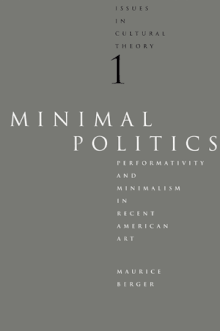 Minimal Politics
Minimal Politics
Published by Center for Art, Design and Visual Culture, UMBC.
Edited by Maurice Berger.
PUBLISHER
Center for Art, Design and Visual Culture, UMBC
BOOK FORMAT
Paperback, 5.25 x 8.25 in. / 200 pgs / 15 bw.
PUBLISHING STATUS
Pub Date 11/2/1997
Out of print
DISTRIBUTION
D.A.P. Exclusive
Catalog: FALL 1997
PRODUCT DETAILS
ISBN 9781890761004 TRADE
List Price: $14.95 CAD $21.00 GBP £12.99
AVAILABILITY
Not available
STATUS: Out of print | 00/00/00 For assistance locating a copy, please see our list of recommended out of print specialists |
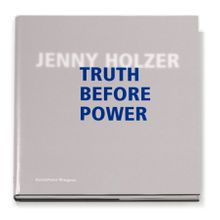 Jenny Holzer: Truth Before Power
Jenny Holzer: Truth Before Power
Published by Kunsthaus Bregenz.
Edited by Eckhard Schneider. Essays by Maurice Berger, Sherman Kent, Thomas Blanton and Eckhard Schneider. Poetry by Henri Cole.
PUBLISHER
Kunsthaus Bregenz
BOOK FORMAT
Clothbound, 11 x 12 in. / 128 pgs / 63 color / 2 bw.
PUBLISHING STATUS
Pub Date 6/15/2004
Out of print
DISTRIBUTION
D.A.P. Exclusive
Catalog: SPRING 2005 p. 146
PRODUCT DETAILS
ISBN 9783883758466 TRADE
List Price: $59.95 CAD $70.00
AVAILABILITY
Not available
STATUS: Out of print | 00/00/00 For assistance locating a copy, please see our list of recommended out of print specialists |
 Postmodernism: A Virtual Discussion
Postmodernism: A Virtual Discussion
Published by The Center for Art, Design and Visual Culture/Georgia O'Keeffe Museum.
Edited by Maurice Berger. Contributions by Robert Rosenblum, Michelle Wallace, Maxwell Anderson, Catherine Lord, Jonathan Weinberg, Olu Oguibe, Michael Leja, Dan Cameron, Yvonne Rainer, Donna deSalvo, Simon Leung, Chrissie Iles, Jennifer Gonzalez, Wendy Ewald, Kellie Jones, David Ross, and Jerry Saltz.
PUBLISHER
The Center for Art, Design and Visual Culture/Georgia O'Keeffe Museum
BOOK FORMAT
Paperback, 9 x 6 in. / 150 pgs.
PUBLISHING STATUS
Pub Date 7/2/2003
Active
DISTRIBUTION
D.A.P. Exclusive
Catalog: FALL 2002
PRODUCT DETAILS
ISBN 9781890761059 TRADE
List Price: $14.95 CAD $21.00 GBP £12.99
AVAILABILITY
In stock
in stock $14.95 Free Shipping UPS GROUND IN THE CONTINENTAL U.S. |
 White: Whiteness And Race In Contemporary Art
White: Whiteness And Race In Contemporary Art
Published by Center for Art, Design and Visual Culture, UMBC.
Edited by Maurice Berger Essays by Maurice Berger, David Roediger and Patricia Williams.
PUBLISHER
Center for Art, Design and Visual Culture, UMBC
BOOK FORMAT
Paperback, 6 x 9 in. / 90 pgs / 12 color.
PUBLISHING STATUS
Pub Date 11/2/2003
Out of print
DISTRIBUTION
D.A.P. Exclusive
Catalog: FALL 2003
PRODUCT DETAILS
ISBN 9781890761066 TRADE
List Price: $14.95 CAD $21.00 GBP £12.99
AVAILABILITY
Not available
STATUS: Out of print | 00/00/00 For assistance locating a copy, please see our list of recommended out of print specialists |
Adrian Piper: A Retrospective, 1965-2000
Issues in Cultural Theory, No. 3
Published by Center for Art, Design and Visual Culture, UMBC.
Artwork by Adrian Piper. Edited by Maurice Berger. Contributions by Jean Fisher, Kobena Mercer. Text by Laura Cottingham.
PUBLISHER
Center for Art, Design and Visual Culture, UMBC
BOOK FORMAT
Paperback, 9 x 12 in. / 230 pgs / 30 color / 50 bw
PUBLISHING STATUS
Pub Date 11/2/1999
Out of print
DISTRIBUTION
D.A.P. Exclusive
Catalog: FALL 1999
PRODUCT DETAILS
ISBN 9781890761028 TRADE
List Price: $25.00 CAD $30.00
AVAILABILITY
Not available
STATUS: Out of print | 8/15/2005 For assistance locating a copy, please see our list of recommended out of print specialists |
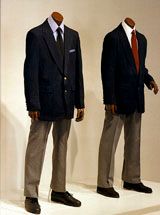 Fred Wilson: Objects And Installations, 1979-2000
Fred Wilson: Objects And Installations, 1979-2000
Issues in Cultural Theory, No. 4
Published by Center for Art, Design and Visual Culture, UMBC.
Edited by John Alan Farmer and Antonia Gardner. Essays by Maurice Berger, Jennifer Gonzalez.
PUBLISHER
Center for Art, Design and Visual Culture, UMBC
BOOK FORMAT
Paperback, 9 x 12 in. / 176 pgs / 120 color / 15 bw.
PUBLISHING STATUS
Pub Date 3/2/2002
Out of print
DISTRIBUTION
D.A.P. Exclusive
Catalog: SPRING 2002
PRODUCT DETAILS
ISBN 9781890761042 TRADE
List Price: $34.95 CAD $40.00
AVAILABILITY
Not available
STATUS: Out of print | 11/28/2010 For assistance locating a copy, please see our list of recommended out of print specialists |
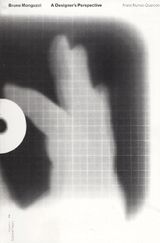 Bruno Monguzzi: A Designer's Perspective
Bruno Monguzzi: A Designer's Perspective
Issues in Cultural Theory 2
Published by Center for Art, Design and Visual Culture, UMBC.
Artwork by Bruno Monguzzi. Edited by Maurice Berger, Franc Nunoo-Quarcoo.
PUBLISHER
Center for Art, Design and Visual Culture, UMBC
BOOK FORMAT
Paperback, 6 x 9 in. / 200 pgs / 80 color / 40 bw.
PUBLISHING STATUS
Pub Date 2/2/1999
Out of print
DISTRIBUTION
D.A.P. Exclusive
Catalog: SPRING 1999
PRODUCT DETAILS
ISBN 9781890761011 TRADE
List Price: $19.95 CAD $27.95 GBP £17.50
AVAILABILITY
Not available
STATUS: Out of print | 00/00/00 For assistance locating a copy, please see our list of recommended out of print specialists |
 Nancy Spero & Leon Golub: Notes In Time
Nancy Spero & Leon Golub: Notes In Time
Notes in Time
Published by Center for Art, Design and Visual Culture, UMBC.
Artwork by Leon Golub, Nancy Spero. Edited by Maurice Berger. Text by Jo Anna Isaak.
PUBLISHER
Center for Art, Design and Visual Culture, UMBC
BOOK FORMAT
Hardcover, 8 x 8 in. / 48 pgs / 18 duotone
PUBLISHING STATUS
Pub Date 10/2/1995
Out of print
DISTRIBUTION
D.A.P. Exclusive
Catalog: FALL 1995
PRODUCT DETAILS
ISBN 9780962456565 TRADE
List Price: $20.00 CAD $25.00
AVAILABILITY
Not available
STATUS: Out of print | 6/1/2001 For assistance locating a copy, please see our list of recommended out of print specialists |

